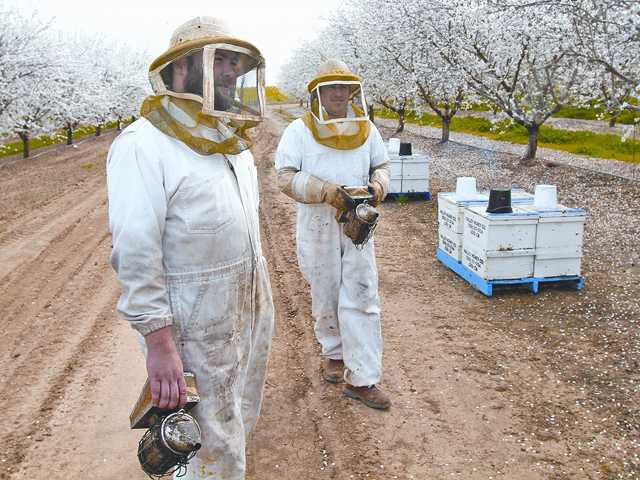The bee invasion is underway.
About 560 billion bees have arrived in the 35,000 acres of almond orchards surrounding Manteca, Ripon, and Escalon.
Almonds are starting to bud a full week earlier than normal due to the dry weather forcing beehive brokers such as Manteca’s Charleen Carroll to scramble to meet the needs of her clients.
“It’s been challenging this year to get and place enough hives but then again it is challenging every year,” said Carroll who is keeping as busy as the bees she brokers this month.
A costly winter bee die-off this past year has proven problematic for many in the beekeeping industry whose commercial box hives pollinate $15 billion worth of crops in the United States.
And the lion’s share of crops benefitting from busy bees is almonds.
In California, there are 860,000 acres of nut bearing almond orchards including 35,000 acres in the South San Joaquin Irrigation District. It is a $4.34 billion statewide crop with San Joaquin County’s share coming in at $469 million. Most of that is from orchards around Manteca, Ripon, and Escalon.
Almonds are also the biggest export crop for California $42.6 billion farming industry that account for $18.8 billion in exports and 15 percent of the nation’s receipts for crops. Eighty percent of the world’s almonds are grown in California. The biggest foreign buyers are China, India, France, Germany, and Canada.
That means there is a lot riding on the bees that Carroll has been helping match beekeepers from across the country with almond growers for the past 35 years. The more the bees cross pollinate the white and pink blooms the better the odds are for bigger yields.
The California almond pollination season is the biggest mobilization of bee hives in the world. It brings hives from the majority of states in the Lower 48 to California. Almonds are also the first crop to get pollinated by bees each year.
There are roughly 80,000 bees per hive. Typically farmers need about two hives per acre. Given that California has 750,000 acres in almonds that’s a lot of hives not to mention bees. There are a a handful of bee brokers in the Central Valley that bring beekeepers from as far away as Texas and Montana to almond growers who need the bees. Carroll places bees from Manteca to as far south as Fresno.
Besides simply brokering the placement of bee hives, Carroll also goes out into the orchards where they are placed to make spot inspections to make sure the bees are adequately producing. If they aren’t it will cost the growers significantly when harvest rolls around.
The fact temperatures are starting to warm up bodes well for the farmers as does the fact the weather outlook doesn’t call for heavy rain in the coming months.
Almond growers rely almost exclusively on honey bees for pollination. They have seen the price of bee rentals increase 30 percent since 2006
That’s the year when bee colony die-offs dubbed “colony collapse disorder” where adult bees vanish from hives leaving behind the queen and younger bees. The die-off rate for the past decade has been around 30 percent while a 19 percent die-off rate is considered sustainable.,
Adding to the problem is the fact there are 2.5 million honey producing colonies kept by professional beekeepers. The US Department of Agriculture indicated that has remained unchanged since 2000. The number of commercial bee colonies has been dropping steadily since the 1940s when there were 6 million hives.
BEE-ZY TIME
Almond pollination underway




